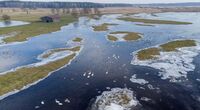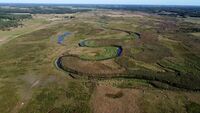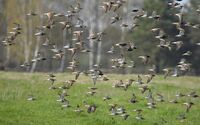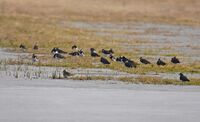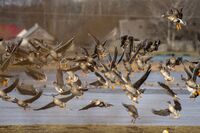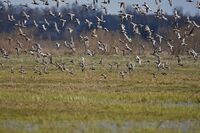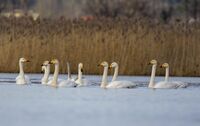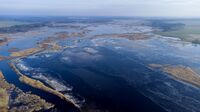Results of improving the condition of wetland bird habitats
The Upper Narew Valley is an area where we have been focusing efforts to improve wetland bird habitat for more than 10 years. Previously, large and dense areas of reed fields and tall herbaceous vegetation replaced the once agriculturally used meadows and pastures. This has dramatically led in a short period of time to a significant depletion of the species composition in terms of breeding and migratory birds found in the valley, as well as reducing the sheer number of individual animals staying there. Fortunately, we have been able to reverse these unfavorable trends. We have restored several hundred hectares of grassland to use, and graze cattle and horses on 300 hectares.
We have been performing breeding bird monitoring on selected plots for several years. We currently decided to identify the status of the population of migrating birds of the Charadriiformes and Anseriformes orders. We conducted counts in the section between the Narew River and Ploski, from 13 observation points, on 5 dates (3 spring counts and 2 autumn counts).
Studies have shown that the locations of bird concentrations during spring migration are clearly correlated with grazing areas. Eight key areas for migrating birds, stretched along the entire surveyed section of the valley, concentrated almost all the birds found during the surveys each time. One such place is the area of Trześcianka, where the tasks of the project we are currently implementing are concentrated.
During the counts, we found 38 species of migratory wetland birds (18 species from the Anseriformes order and 20 species from the Charadriiformes order). We recorded the highest maximum counts for Geese. By mid-March, their numbers had reached about 6,300 individuals. They were mainly greater White-fronted geese with a small number of Tundra bean geese, which reach their peak migration earlier. During the first survey in March, we observed species such as Mallards (500 individuals), Eurasian wigeons (660 individuals) and Northern pintails (200 individuals). In mid-April, there was a peak in the flight of Garganeys, Eurasian teals, Shovelers, and Gadwalls (up to 26, 900, 250, and 60 individuals, respectively). We observed a mixed flock of Tufted ducks(50 individuals), Pochards (22 individuals) and single Scaupsduring two April surveys. We recorded the presence of Mute swans (up to 68 individuals) and Whooper swans (up to 35 individuals) at each of the spring surveys conducted.
From mid-April, the migration period of most Charadriiformes begins in the Narew Valley. This does not apply to a fairly early migrant - Ruff, which is already reaching its highest numbers and is the most numerous representative of its order here during the spring migration (1,050 individuals). Other more numerous species observed in the spring included Lapwings (166 individuals), Black-headed gulls (240 individuals), Black-tailed godwits (10 individuals), Common greenshank (24 individuals), and Wood sandpipers (230 individuals found during an additional inspection in May), White-winged tern (50 individuals).
In spring, therefore, the upper Narew Valley is a very important point on the migration route of wetland birds and a popular resting and foraging area. In autumn, the river flowing in its bed, without even small broads forming, is avoided by wetland birds, which, in much smaller numbers than in spring, may use the Narew Valley as a migration corridor, but do not stop there to rest. At that time, we only noted the presence of small groups of Mallards on the river.
The inventory on behalf of PTOP was carried out by ornithologistsTowarzystwo Przyrodnicze Dubelt (Dubelt Nature Society).
Photos: Grzesiek Grygoruk

